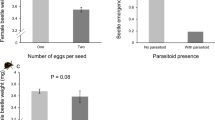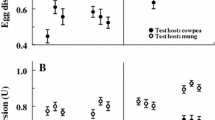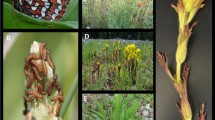Abstract
The colonization of an exotic species by native herbivores is more likely to occur if that herbivore is a generalist. There is little information on the life-history mechanisms used by native generalist insects to colonize exotic hosts and how these mechanisms are affected by host properties. We examined the ability of the generalist seed beetle Stator limbatus Horn to colonize an exotic species. We compared its host preference, acceptability, performance, and egg size when ovipositing and developing on two native (Pithecellobium dulce (Roxb.) Benth and Senegalia riparia (Kunth)) and one exotic legume species (Leucaena leucocephala (Lam.)). We also analyzed the seed chemistry. We found that females recognize the exotic species as an unfavorable host for larval development and that they delayed oviposition and laid fewer and larger eggs on the exotic species than on the native species. Survivorship on the exotic host was 0%. Additionally, seeds of the native species contain five chemical compounds that are absent in the exotic species, and the exotic species contains three sterols, which are absent in the native legumes. Genetically based differences between beetles adapted to different hosts, plastic responses toward new hosts, and chemical differences among seeds are important in host colonization and recognition of the exotic host. In conclusion, the generalist nature of S. limbatus does not influence its ability to colonize L. leucocephala. Explanations for the colonization of exotic hosts by generalist native species and for the success of invasive species must be complemented with studies measuring local adaptation and plasticity.







Similar content being viewed by others
References
Abramoff MD, Magalhaes PJ, Ram SJ (2004) Image processing with Image J. Biophoton Int 11(36):42
Akhtar S (1992) Chemical and nutritional evaluation of the genus Acacia of the family Leguminosae of Pakistan. PhD Thesis. University of the Punjab, Lahore, Pakistan, p 240
Amarillo-Suárez AR (2006) Influences of host size and host quality on host use in a seed-feeding beetle. Dissertation, p 118
Amarillo-Suárez AR, Fox CW (2006) Population differences in host use by a seed-beetle: local adaptation, phenotypic plasticity and maternal effects. Oecologia 150:247–258
Awmack CS, Leather SR (2002) Host plant quality and fecundity in herbivorous insects. Annu Rev Entomol 47:817–844
Borges RM, Bessière J, Hossaert-McKey M (2008) The chemical ecology of seed dispersal in monoecious and dioecious figs. Funct Ecol 22:484–493
Callaway RM, Ridenour WM (2004) Novel weapons: invasive success and the evolution of increased competitive ability. Front Ecol Environ 2:436–443
Clark AJ, Block K (1959) The absence of sterol synthesis in insects. J Biol Chem 234:2578–2582
Crawley MJ (1984) Herbivory: the dynamics of animal-plant interactions. Blackwell, Oxford, p. 437
Cope JM, Fox CW (2003) Oviposition decisions in the seed beetle, Callosobruchus maculatus (Coleoptera: Bruchidae): effects of seed size on superparasitism. J Stored Prod Res 39:355–365
Czesak ME, Fox CW (2003) Evolutionary ecology of egg size and number in a seed beetle: genetic trade-off differs between environments. Evolution 57:1121–1132
Fox CW (2006) Colonization of a new host by a seed-feeding beetle: genetic variation, maternal experience, and the effect of an alternate host. Ann Zool Fenn 43:239–247
Fox CW, Czesak ME (2000) Evolutionary ecology of progeny size in arthropods. Annu Rev Entomol 45:341–369
Fox CW, Czesak ME (2009) Adaptive maternal effects: a case study of egg-size plasticity in a seed-feeding beetle. In: Whitman DW, Ananthakrishnan TN (eds) Phenotypic plasticity of insects: mechanisms and consequences. Science Publishers, Enfield, NH, pp. 781–815
Fox CW, Gordon DM, Bojang P (2006) Genetic and environmental sources of variation in survival on nonnative host species in the generalist seed beetle, Stator limbatus. Southwest Nat 51:490–501
Fox CW, Mousseau TA (1995) Determinants of clutch size and seed preference in a seed beetle, Stator beali (Coleoptera: Bruchidae). Environ Entomol 24:1557–1561
Fox CW, Mousseau TA (1996) Larval host plant affects fitness consequences of egg size variation in the seed beetle Stator limbatus. Oecologia 107:541–548
Fox CW, Savalli UM (2000) Maternal effects mediate host expansion in a seed-feeding beetle. Ecology 81:3–7
Fox CW, Wadedell K, Des Lauries J, Mousseau T (1997) Seed beetle survivorship, growth and egg size plasticity in a paloverde hybrid zone. Ecol Entomol 22:416–424
García-Robledo C, Horvitz CC (2012) Jack of all trades masters novel host plants: positive genetic correlations in specialist and generalist insect herbivores expanding their diets to novel hosts. J Evol Biol 25:38–53
Global Invasive Species Database (2016) Species profile: Leucaena leucocephala. http://www.iucngisd.org/gisd/species.php?sc=23. Accessed 27 July 2016
Hassell MP, Southwood TRE (1978) Foraging strategies of insects. Annu Rev Ecol Syst 9:75–98
Janzen DH (1980) Specificity of seed-attacking beetles in a Costa Rican deciduous forest. J Ecol 68:929–952
Johnson CD (1981a) Host preferences of stator (Coleoptera: Bruchidae) in non-host seeds. Environ Entomol 10:857–863
Johnson CD (1981b) Interactions between bruchid (Coleoptera) feeding guilds and behavioral patterns of pods of the Leguminosae. Environ Entomol 10:249–253
Keane R, Crawley MJ (2002) Exotic plant invasions and the enemy release hypothesis. Trends Ecol Evol 17:164–170
Keeler MS, Chew FS (2008) Escaping an evolutionary trap: preference and performance of a native insect on an exotic invasive host. Oecologia 156:559–568
Khan R, Srivastava R, Khan M, Alam P, Abdin MZ (2012) Variation in oil content and fatty acid composition of the seed oil of Acacia species collected from the northwest zone of India. J Sci Food Agric 92:2310–2315
Kirichenko N, Péré C, Baranchikov Y, Schaffner U, Kenis M (2013) Do alien plants escape from natural enemies of congeneric residents? Yes but not from all. Biol Invasions 15:2105–2113
Klowdern MJ (2007) Physiological systems in insects, 2nd edn. Elsevier, Amsterdam, p. 688
Lande R (2009) Adaptation to an extraordinary environment by evolution of phenotypic plasticity and genetic assimilation. J Evol Biol 22:1435–1446
Leger EA, Forister ML (2005) Increased resistance to generalist herbivores in invasive populations of the California poppy (Eschscholzia californica). Divers Distrib 11:311–317
Lind EM, Parker JD (2010) Novel weapons testing: are invasive plants more chemically defended than native plants? PLoS One 5:e10429
Memmott J, Fowler SV, Paynter Q, Sheppard AW, Syrett P (2000) The invertebrate fauna on broom, Cytisus scoparius, in two native and two exotic habitats. Acta Oecol 21:213–222
Mondy N, Corio-Costet MF, Bodin A, Mandon N, Vannier F, Monge JP (2006) Importance of sterols acquired through host feeding in synovigenic parasitoid oogenesis. J Insect Physiol 52:897–904
Morse GE (2003) Ecological and evolutionary diversification in seed beetles (Coleoptera Bruchinae). PhD Thesis. Department of Organismic and Evolutionary Biology, Harvard University, Boston, Massachussetts
Morse GE, Farrell BD (2005a) Ecological and evolutionary diversification of the seed beetle genus stator (Coleoptera: Chrysomelidae: bruchinae). Evolution 59:1315–1333
Morse GE, Farrell BD (2005b) Interspecific phylogeography of the Stator limbatus species complex: the geographic context of speciation and specialization. Mol Phylogenet Evol 36:201–213
Orwa C, Mutua A, Kindt R, Jamnadass R, Simons A (2009) Agroforestree database: a tree reference and selection guide version 4.0. http://www.worldagroforestry.org/treedb/AFTPDFS/Leucaena_leucocephala.PDF. Accessed 8 December 2015
Pearse IS, Harris DJ, Karban R, Sih A (2013) Predicting novel herbivore-plant interactions. Oikos 122:1554–1564
Repizo A, Devia C (2008) Árboles y arbustos del valle seco del río Magdalena y de la región caribe Colombiana: Su ecología y usos. Bogotá, Pontificia Universidad Javeriana
Savalli U, Fox CW (2002) Proximate mechanisms influencing egg-size plasticity in the seed beetle Stator limbatus (Coleoptera: Bruchidae). Ann Entomol Soc Am 95:724–734
Schlichting CD, Wund MA (2014) Phenotypic plasticity and epigenetic marking: an assessment of evidence for genetic accommodation. Evolution 68:656–672
Singer MC (2000) Reducing ambiguity in describing plant-insect interactions: “preference”, “acceptability” and “electivity”. Ecol Lett 3:159–162
StatSoft I (2005) Statistica (data analysis software system), Version 8
Tallamy DW, Ballard M, D’Amico V (2010) Can alien plants support generalist insect herbivores? Biol Invasions 12:2285–2292
Tuda M, Wu LH, Yamada N, Wang CP, Wu WJ, Buranapanichpan S, Kagoshima K, Chen Z-Q, Teramoto KK, Kumashiro BR, Heu R (2014) Host shift capability of a specialist seed predator of an invasive plant: roles of competition, population genetics and plant chemistry. Biol Invasions 16:303–313
Vázquez-Yanes C, Muñoz AI, Silva AMI, Gual Díaz M, Sánchez Dirzo C (1999) Árboles y arbustos potencialmente valiosos para la restauración ecológica y la reforestación. Reporte técnico del proyecto, Vol. J 84. Mexico City, Mexico, CONABIO—Instituto de Ecología, UNAM
Via S (1990) Ecological genetics and host adaptation in herbivorous insects: the experimental study of evolution in natural and agricultural systems. Annu Rev Entomol 35:421–446
Wagner H, Bladt S (1996) Plant drug analysis. A thin layer chromatography atlas, 2nd edn. Springer Verlag, Berlin
Xiong W, Yu D, Wang Q, Liu C, Wang L (2008) A snail prefers native over exotic freshwater plants: implications for the enemy release hypotheses. Freshwat Biol 53:2256–2263
Zolotar’ RM, Bykhovets AI, Kashkan ZN, Chernov YG, Kovganko NV (2002) Structure-activity relationship of insecticidal steroids. VII. C-7-oxidized β-sitosterols and stigmasterols. Chem Nat Compd 38:171–174
Acknowledgements
Financial support for this study was obtained from the Pontificia Universidad Javeriana grant to project 4636. Tyffany Harwell provided invaluable laboratory assistance. Sergio Collazos assisted with the collection of seeds in the field, and Alejandra Castro assisted with the sorting of seeds in the lab. Francis G. Howarth and two reviewers provided insightful comments that improved the final version of the manuscript.
Author information
Authors and Affiliations
Corresponding author
Additional information
Edited by Raul Laumann – Embrapa
Rights and permissions
About this article
Cite this article
Amarillo-Suárez, A., Repizo, A., Robles, J. et al. Ability of a Generalist Seed Beetle to Colonize an Exotic Host: Effects of Host Plant Origin and Oviposition Host. Neotrop Entomol 46, 368–379 (2017). https://doi.org/10.1007/s13744-016-0476-9
Received:
Accepted:
Published:
Issue Date:
DOI: https://doi.org/10.1007/s13744-016-0476-9




